The manatee is Florida’s gentle giant, a water-dwelling beauty that is on many nature lovers’ must-see list. Sea cows, as manatees are also called, live in the mangroves and springs of Florida’s southern coastal areas, peaceful grazing in the shallow waters. They are one of Earth’s oldest and most enigmatic creatures, and the chance the see manatees in Florida is one that you will not regret taking. If an encounter with these wonderful animals is at the top of your vacation to-do list, read on to find out where they are and how you can see them in a responsible and sustainable way.
Are manatees native to Florida?
Manatees are indeed native to Florida, as fossil records show evidence of them in the region for many thousands of years.
How many manatees are in Florida?
It’s difficult to know exactly how many manatees live in Florida, but recent aerial surveys suggest that there are between 4000 and 5500 of them. They are an endangered species, but it is hoped the population is in recovery.

Where is the best place to see manatees in Florida?
Manatees live in the waters of southeast Florida, and although they are pretty hefty in size, that doesn’t necessarily mean that they are easy to find! As with all wildlife, sightings are never guaranteed, but knowing where to find manatees in Florida based on where they usually go is a good starting point.
- Blue Spring State Park, Orange City – Encompassing more than 1500 acres, Blue Spring is the largest designated manatee refuge on the St Johns River. During manatee season the spring run is closed however the park provides plenty of overlooks and boardwalks for manatee viewing.
- The Manatee Observation and Education Centre, Fort Pierce – Located on Florida’s beautiful east coast this manatee viewing facility overlooks the nationally recognized Indian River Lagoon and Moore’s Creek; both popular resting spots for the Florida manatee. You might also see a variety of other wildlife including dolphins, pelicans and terns, as well as exotic plants.
- Crystal River – This area has a large number of manatees who migrate here for the winter. Visitors can take a scenic tour by boat or kayak.
- Lee County Manatee Park, Fort Myers – This 17-acre park was built in 1996 as a non-captive refuge for the Florida manatee. Optimum viewing times between the months of November and March, the park also has an extensive butterfly garden with birds and other wildlife found throughout the grounds.
- Everglades National Park – The largest subtropical wilderness in the United States, the Everglade’s National Park is a protective habitat for numerous endangered species including the manatee, the American crocodile, and the Florida panther. The park is a World Heritage Site, an International Biosphere Reserve, a Wetland of International Importance, and a protected area under the Cartagena Treaty.
When is the best time for manatee watching in Florida?
Between mid-November and March is the best time to see manatees in Florida. The creatures migrate to the warm water of the Florida Springs for the winter season.
Can I swim with manatees in Florida?
Manatees are extremely precious creatures. There is strict legislation in place to protect them and help them recover their numbers. For this reason, it is only legal to swim with or touch manatees in one place in Florida; Crystal River. It is about 90 minutes north of Tampa. You will need to go through induction on all the dos and don’ts before going into the water.
Where to kayak with manatees in Florida
Crystal River is also a great place to kayak with manatees. Kayaking is a wonderful way to explore the springs and get closer to the animals in a non-harmful. During the peak manatee season, you cannot kayak with the manatees; only when numbers are fewer and the water is less crowded. Some areas of the springs are closed off for the manatee’s protection, and touching the animals is not allowed.

Manatee facts
- Manatees evolved from four-legged land mammals over 60 million years ago.
- They can live for up to 60 years.
- The biggest specimens measure up to 13 feet in length and weigh as much as 1300lbs.
- Manatees have perfected an enviably laid-back exisitance, spending their days drifting and eating. They use their large pectoral flippers to ‘walk’ along the bottom of the substrate.
- An adult manatee will graze for up to 7 hours a day. They consume up to 15% of their own body weight each day.
- The closest living relative of the manatee is the elephant.
- Many of the ‘mermaids’ that explorers and sailors, incluidng Christopher Columbus, reported seeing, were in fact manatees.
- Manatees have the lowest brain-to-body-size ratio of any living mammal.
- They have no natural predators – it is humans that have caused all three sub-species of manatees to approach extinction. The majority of manatee deaths happen because of collisions with boat propellors. That’s why many Everglades tour companies have switched to airboats.
Book your Florida vacation rental with Top Villa
Heading to the Sunshine State? Check out our range of beautiful Florida vacation rentals and villas. Choose from a fantastic range, from oceanfront properties in Miami to family homes in Orlando. Our luxury rentals have the best facilities on the market. Find homes with private pools, themed rooms, and additional Concierge services such as private chefs, bookable through our website.




